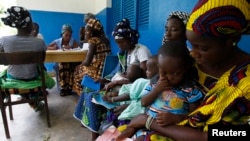Hello, again, and welcome. I’m Jim Tedder in Washington. Have you ever heard anyone say, “I hate listening to the news. It’s always bad!” Well, today we are happy to tell you that the news is good.
Three agencies concerned with world health have announced the good news.Their joint report says worldwide deaths among children under age five is almost half that of 22 years ago. We’ll have the details.
Then we will hear about a law professor from Iraqi Kurdistan who recently visited some of the best law schools in the United States. We find out what he learned, and what ideas he took home with him. Those are the two main topics of conversation today as you learn English with As It Is on VOA.
Number of Child Deaths Decreases Worldwide
Three agencies concerned with world health have good news to report. The say the number of deaths among children under age five is almost half of what it was 22 years ago. The United Nations Children’s Emergency Fund, the World Health Organization and the World Bank say about 6.6 million children died before reaching their fifth birthday in 2012. That compares with 12 million children under age five who died in 1990.
Elizabeth Mason is with the World Health Organization. She says the first 28 days of life are extremely important for a child’s survival. Ms. Mason says survival is linked to the care the mother receives during pregnancy. Most importantly, she says, it is connected to care during labor, childbirth and the baby’s first hours. She says good care can save premature babies -- those born too soon.
“We have new low-cost solutions that can reduce deaths of pre-term babies by up to three-quarters.”
She notes that pregnant women can receive injections to prevent labor that starts before the child is fully develped and ready to be born. Kangaroo-mother care is another way to help premature babies. In this method, the newborn is put into a pouch, or bag, next to the mother’s chest. The baby can then keep warm and can have breast milk when hungry.
The leading causes of death among children under five include premature birth and lack of oxygen before, during or after birth. Other causes include lung infection and the disease malaria. The World Health Organization says about 45 percent of children under five die because of a lack of nutritious food.
Half of all deaths of children under five take place in five countries. They are China, the Democratic Republic of Congo, India, Nigeria and Pakistan. The new report says the world's highest child death rate is found in African countries south of the Sahara desert. In that area, 98 of 1,000 children born alive in the area do not survive to their fifth birthdays.
Children born in sub-Saharan Africa face more than 16 times the threat of dying before the fifth birthday than a child born in a wealthy country. But the number of deaths has dropped sharply since 1990.
Mark Young is a top health advisor at the United Nations Children’s Fund, UNICEF. He says economic development helps reduce child deaths. But he says poor countries that have a good plan of action can make major gains. For example, Mr. Young notes progress in Niger, one of the poorest countries in West Africa. Niger has cut its rate of deaths of children under five by almost 66 percent in the last 20 years.
He says it has done this through a series of actions led by the government and supported by UNICEF.
”They instituted a free health care policy for women and children, abolished user fees, so increased financial access. They expanded geographic access by establishing a series of rural health posts.”
He says they also organized campaigns to provide a number of preventative interventions to the people.
A Middle Easterner Observes the American Law System
There is an organization here in the United States that believes in letting foreigners get a first-hand look at democracy at work. Christopher Cruise tells us what one Middle Easterner saw when he came to observe the American legal system.
A law professor from Iraqi Kurdistan recently had a chance to tour some of the top law schools in the United States. The visits were part of a program at Syracuse University in New York. The Civic Education and Leadership Fellows program, or CELF, is funded by the State Department. Academics in the social sciences from the Middle East and North Africa spend a few months at the Maxwell School for Citizenship and Public Affairs at Syracuse.
The academic program offers course work and individual development of projects to help deepen understanding of democracy and democratic reform. The program at Syracuse is aimed at encouraging greater involvement in civic life.
Nasir Khalil Al-Assaf is an associate professor in the College of Law and Politics at Salahaddin University in Erbil.
While visiting the law schools, he said, he was impressed by the amount of educational materials available to students.
“When I visited Yale Law School -- which is one of the biggest law schools in USA -- one of the professors took me to the library and show me the library in this school, which is more than seven floors and contains more than one million books.”
During the visits, Professor Al-Assaf also observed legal clinics in which law students work with people who need legal aid. Some legal education experts would like to see law schools in the United States increase practical work experience like this for their students. The professor says law education in Iraq focuses more on reading and theory than on practical work.
“After my visit to the more than 10 best law schools in USA, I observed that these schools focus on practical subjects through legal clinics. The clinics in [the] USA law schools make the students more qualified and make them ready to practice the law when they graduate from law schools."
He said Iraqi law students often face difficulties when they graduate because they lack practical experience. He noted a big difference between reading the law and practicing it.
At Syracuse, Nasir Kahlil Al-Assaf said he has developed new ideas about legal education. He created a project for when he returns home. He wants to create a bridge between the law school and the local community in Kurdistan.
The project calls for students and professors to volunteer in the community. He said he wants to adopt the example of law students working in legal clinics. That way, he says, poor people can get legal help at the same time students get more chances to practice being a lawyer.
I’m Christopher Cruise.
And I’m Jim Tedder in Washington. Thank you for spending some time with us today. Two more Learning English programs are straight ahead, and there's world news at the beginning of the hour on VOA.








